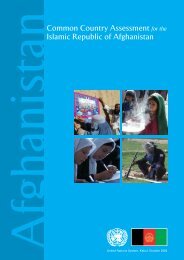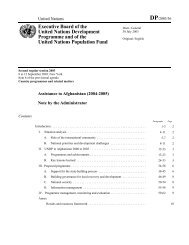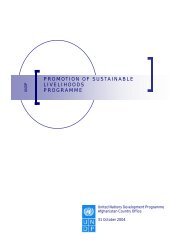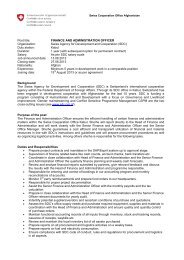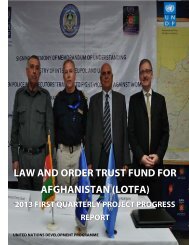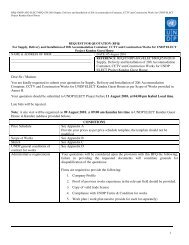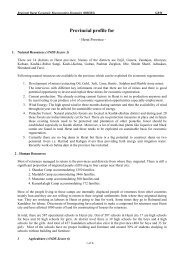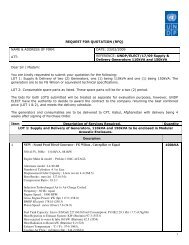E N S W - Human Development Reports - United Nations ...
E N S W - Human Development Reports - United Nations ...
E N S W - Human Development Reports - United Nations ...
You also want an ePaper? Increase the reach of your titles
YUMPU automatically turns print PDFs into web optimized ePapers that Google loves.
BOX 3.4<br />
Investing in agriculture<br />
Strategic investments in the agricultural sector can have transformative<br />
effects. Higher crop yields not only lead to improved livelihoods for farmers,<br />
they also increase demand for goods and services in rural areas, giving<br />
rise to new opportunities for economic development. They may also lead to<br />
lower food prices, reducing the share of food in household expenditures and<br />
creating markets for other sectors of the economy.<br />
Agricultural research is a public good and tends to be underprovided<br />
by the private sector. Consequently, governments can make useful<br />
contributions in this area. Recent studies on several African, Asian<br />
and Latin American countries show that increased public spending on<br />
agriculture is particularly good for promoting growth. Disaggregating<br />
agricultural expenditure into research and nonresearch spending shows<br />
that research spending is especially effective. Provision of other public<br />
goods, such as agricultural extension services and irrigation systems, is<br />
also beneficial.<br />
China has the world’s largest agricultural research and development<br />
system in the world. Its research is based at the Chinese Academy of<br />
Agricultural Sciences, universities and the Chinese Academy of Science,<br />
which together comprise of more than 1,100 research institutions. China is<br />
becoming a leader in South–South cooperation with African countries, many<br />
of which are now benefiting from its research.<br />
Agricultural technology has also been a strength of Brazil, where an<br />
estimated 41% of 2006 agricultural research spending in Latin America occurred.<br />
The System for Agricultural Research and Innovation has contributed<br />
greatly to the nearly fourfold growth in agricultural efficiency per worker.<br />
The Brazil Agricultural Research Corporation, a state-owned enterprise, has<br />
been instrumental in increasing the land area used for cultivation. Similarly,<br />
many of Brazil’s agricultural programmes were developed with sustainability<br />
in mind. For example, to qualify for price support and credit programmes,<br />
farmers must respect zoning laws. Another programme, Moderagro, provides<br />
farmers with credit to improve agricultural practices and preserve<br />
natural resources, Produsa provides credit for planting on agricultural land<br />
that has degraded soil and Propflora uses credit to encourage the planting of<br />
forests (particularly palm oil).<br />
Source: OECD 2006, 2011a; Fan and Saurkar 2006; Fan, Nestorova and Olofinbiyi 2010; Stads and Beintema 2009; World Bank 2012a.<br />
Each phase thus involved a people- centred<br />
approach in which the growth strategy<br />
was modified in response to changing<br />
conditions.<br />
Enhancing public investment<br />
Traditional economic and social policy<br />
thinking, as emphasized by the “Washington<br />
Consensus”, focused on getting economic fundamentals<br />
right as a precondition for economic<br />
growth, arguing that other human development<br />
improvements would follow. A human<br />
development approach, on the other hand, demands<br />
that improvement in poor people’s lives<br />
not be postponed. Thus, people-friendly developmental<br />
states are those that expand a number<br />
of basic social services (box 3.5). 20 In this view,<br />
investing in people’s capabilities—through<br />
health, education and other public services—is<br />
not an appendage of the growth process but an<br />
integral part of it.<br />
In addition to the levels of public expenditures,<br />
their composition and the efficiency with<br />
which they are delivered, all taken together, influence<br />
the effective delivery of public services<br />
and expansion of capabilities. The effectiveness<br />
of public expenditure differs across countries.<br />
A global cross-country analysis shows a<br />
positive correlation between previous public<br />
expenditure per capita on health and education<br />
and current human development achievement<br />
(figure 3.2). Also, higher previous public<br />
spending per capita on health is associated with<br />
better child survival and lower under-five child<br />
mortality rates (figure 3.3). Such outcomes<br />
naturally depend on a country’s stage of development<br />
and on how well the money is spent.<br />
Countries should put in place checks and balances<br />
to prevent reckless borrowing sprees and<br />
wasteful spending.<br />
There has been much debate about whether<br />
public investment crowds in or crowds out<br />
private investment. Both outcomes are possible<br />
because of the many different uses of<br />
public capital in developing countries. From<br />
the lower levels of health, education and<br />
infrastructure development in South Asia<br />
and Sub-Saharan Africa than in the highperforming<br />
countries of East and Southeast<br />
Asia, it is reasonable to infer that public investment,<br />
as well as its composition, performs<br />
a critical role.<br />
• Bangladesh. Bangladesh has sustained<br />
growth in part by increasing the rate of public<br />
investment over time while avoiding the<br />
fiscal deficits that have plagued the rest of the<br />
region.<br />
Investing in people’s<br />
capabilities—through<br />
health, education and<br />
other public services—is<br />
not an appendage of<br />
the growth process but<br />
an integral part of it<br />
Chapter 3 Drivers of development transformation | 69



